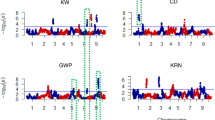Abstract
Genetic factors controlling quantitative inheritance of grain yield and its components have not previously been investigated by using replicated lines of an elite maize (Zea mays L.) population. The present study was conducted to identify quantitative trait loci (QTLs) associated with grain yield and grain-yield components by using restriction fragment length polymorphism (RFLP) markers. A population of 150 random F2∶3 lines was derived from the single cross of inbreds Mo17 and H99, which are considered to belong to the Lancaster heterotic group. Trait values were measured in a replicated trial near Ames, Iowa, in 1989. QTLs were located on a linkage map constructed with one morphological and 103 RFLP loci. QTLs were found for grain yield and all yield components. Partial dominance to overdominance was the primary mode of gene action. Only one QTL, accounting for 35% of the phenotypic variation, was identified for grain yield. Two to six QTLs were identified for the other traits. Several regions with pleiotropic or linked effects on several of the yield components were detected.
Similar content being viewed by others
References
Bauman LF (1981) Review of methods used by breeders to develop superior corn inbreds. Proc Corn Sorghum Ind Res Conf 36:199–208
Beavis WD, Grant G, Albertsen M, Fincher R (1991) Quantitative trait loci for plant height in four maize populations and their associations with qualitative genetic loci. Theor Appl Genet 83:141–145
Cochran WG, Cox GM (1957) Experimental designs. John Wiley and Sons, New York
Cowen NM (1988) The use of replicated progenies in marker-based mapping of QTLs. Theor Appl Genet 75:857–862
Doebley J, Stec A, Wendel J, Edwards M (1990) Genetic and morphological analysis of a maize-teosinte F2 population: Implications for the origin of maize. Proc Natl Acad Sci USA 87:9888–9892
Edwards MD, Stuber CW, Wendel JF (1987) Molecular-marker-facilitated investigations of quantitative-trait loci in maize. I. Numbers, genomic distribution and types of gene action. Genetics 116:113–125
Edwards MD, Helentjaris T, Wright S, Stuber CW (1992) Molecular-marker-facilitated investigations of quantitative trait loci in maize. 4. Analysis based on genome saturation with isozyme and restriction fragment length polymorphism markers. Theor Appl Genet 83:765–774
Freymark PF, Lee M, Woodman WL, Martinson CA (1993) Quantitative and qualitative trait loci affecting host-plant response to Exserohilum turcicum in maize (Zea mays L.). Theor Appl Genet 87:537–544
Hallauer AR, Miranda JB (1988) Quantitative genetics in maize breeding, 2nd edn. Iowa State University Press, Ames, Iowa
Hayman BI (1958) The separation of epistatic from additive and dominance variation in generation means. Heredity 12:371–390
Knapp SJ, Bridges WC (1990) Using molecular markers to estimate quantitative trait locus parameters: power and genetic variances for unreplicated and replicated progeny. Genetics 126:769–777
Knapp SJ, Stroup WW, Ross WM (1985) Exact confidence intervals for heritability on a progeny mean basis. Crop Sci 25:192–194
Knott SA, Haley CS (1992) Aspects of maximum likelihood methods for the mapping of quantitative trait loci in line crosses. Genet Res 60:139–151
Lande R (1981) The minimum number of genes contributing to quantitative variation between and within populations. Genetics 99:541–553
Lander ES, Botstein D (1989) Mapping Mendelian factors underlying quantitative traits using RFLP linkage maps. Genetics 121:185–19
Lande R, Thompson R (1990) Efficiency of marker-assisted selection in the improvement of quantitative traits. Genetics 124: 743–756
Mather K, Jinks JL (1971) Biometrical genetics. Chapman and Hall, London
Melchinger AE, Messmer MM, Lee M, Woodman WL, Lamkey KR (1991) Diversity and relationships among U.S. maize inbreds revealed by restriction fragment length polymorphisms. Crop Sci 31:669–678
Moll RH, Lindsey MF, Robinson HF (1964) Estimates of genetic variances and level of dominance in maize. Genetics 49:411–423
Ottaviano E, Sari Gorla M, Pè E, Frova C (1991) Molecular markers (RFLPs and HSPs) for the genetic dissection of thermotolerance in maize. Theor Appl Genet 81:713–719
Paterson AH, Damon S, Hewitt JD, Zamir D, Rabinowitch HD, Lincoln SE, Lander ES, Tanksley SD (1991) Mendelian factors underlying quantitative traits in tomato: comparison across species, generations, and environments. Genetics 127:181–197
Reiter RS, Coors JG, Sussman MR, Gableman WH (1991) Genetic analysis of tolerance to low-phosphorus stress in maize using restriction fragment length polymorphisms. Theor Appl Genet 82:561–568
Russell WA, Hallauer AR, Lamkey KR, White PR (1989) Iowa experimental corn trials. Iowa Coop Ext Serv Publ AG129, Ames, Iowa
Salazar AM, Hallauer AR (1986) Divergent mass selection for ear length in maize. Rev Bras Genet 9:281–294
Schön CC, Lee M, Melchinger AE, Guthrie WD, Woodman WL (1993) Mapping and characterization of quantitative trait loci affecting resistance against second-generation European corn borer in maize with the aid of RFLPs. Heredity 70:648–659
Shapiro SS, Wilk MB (1965) An analysis of variance for normality (complete samples). Biometrika 52:591–611
Stuber CW, Edwards MD, Wendel JF (1987) Molecular-marker-facilitated investigations of quantitative trait loci in maize. II. Factors influencing yield and its component traits. Crop Sci 27:639–648
Veldboom LR, Lee M, Woodman WL (1994) Molecular-marker-facilitated studies of morphological traits in maize. I. Linkage analysis and determination of QTLs for morphological traits. Theor Appl Genet 88:7–16
Author information
Authors and Affiliations
Additional information
Communicated by J. Mackey
Rights and permissions
About this article
Cite this article
Veldboom, L.R., Lee, M. Molecular-marker-facilitated studies of morphological traits in maize. II: Determination of QTLs for grain yield and yield components. Theoret. Appl. Genetics 89, 451–458 (1994). https://doi.org/10.1007/BF00225380
Received:
Accepted:
Issue Date:
DOI: https://doi.org/10.1007/BF00225380




